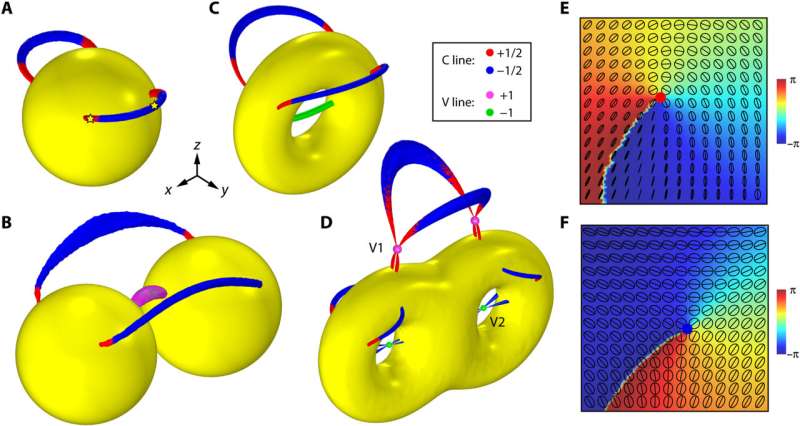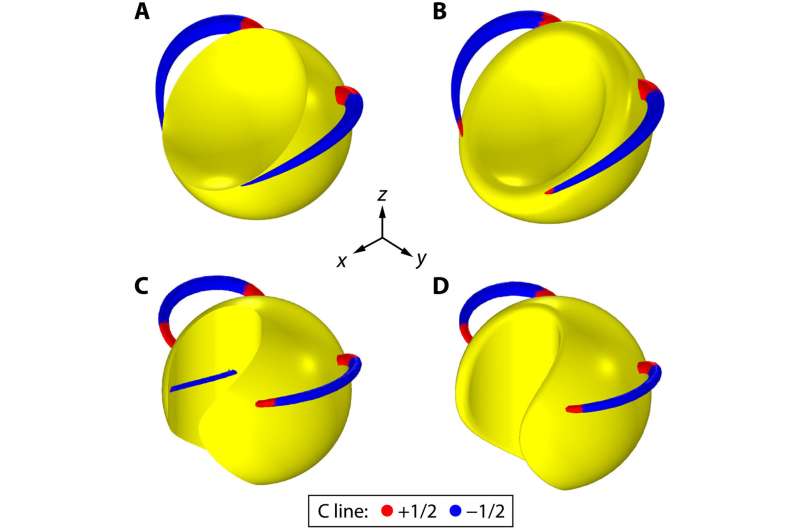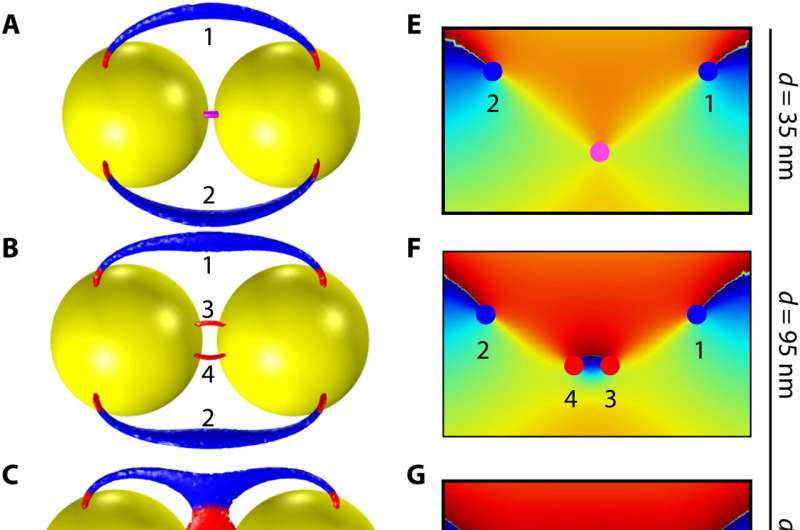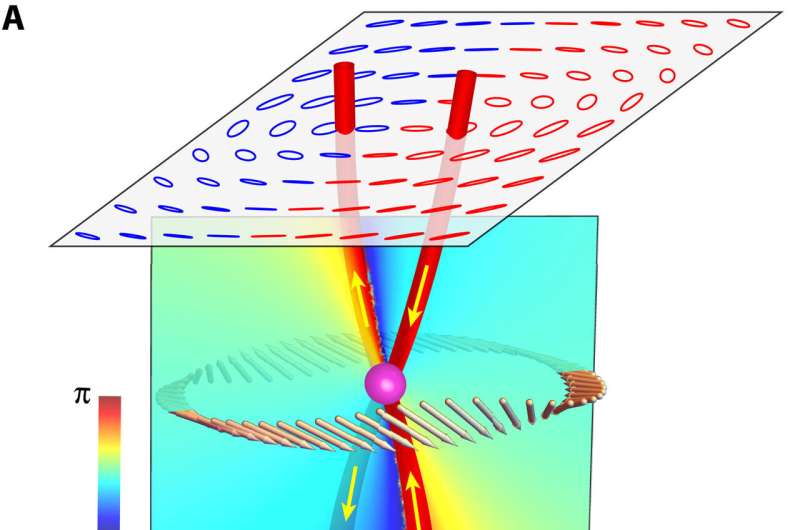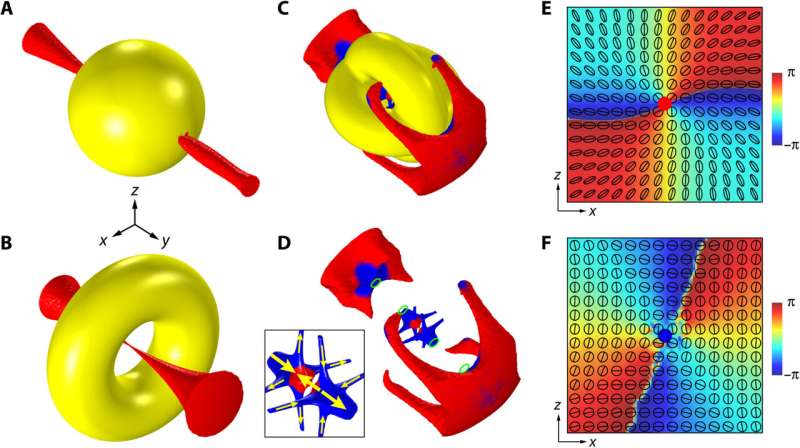Polarization singularities generated by topological structures. (A to D) The C lines (blue/red) and V lines (magenta/green) generated by metal structures (yellow) with Euler characteristic χ = +2, +4,0, −2. The small magenta and green spheres in (D) denote the V points formed by crossings of C lines. (E and F) Polarization ellipses and Arg(Ψ) on a plane for the C points marked by the stars in (A). The planes are perpendicular to the local spin at the C points. The line segments in the ellipses denote the polarization major axes. The colors show the value of Arg(Ψ). Credit: Science Advances (2022). DOI: 10.1126/sciadv.abq0910
Metamaterials and metaoptics offer a broad dimension to explore exotic functionalities in physics and optics. In a new report now published in Science Advances, Jie Peng and a team of scientists in physics and interdisciplinary studies at the City University of Hong Kong, China, discovered how the topology of structures can dictate the properties of optical fields to offer a new dimension of exploration in optic functionalities.
The nontrivial topology of metal structures facilitated the birth of polarization singularities, and the outcomes of the study bridge singular optics, topological photonics, and non-Hermitian physis for applications across chiral sensing, quantum optics and photonics.
A universal connection between topology and optical structures
The concept of topology can provide new perspectives for physicists to explore unconventional properties of one-way edge states in topological insulators and their counterparts. The distribution of polarization ellipses can form topological defects known as polarization singularities, which emerge during applications such as light focusing, scattering and interference in nanostructures including meta-surfaces and photonic crystals. The geometry of optical structures can still decide the local resonance of optical modes to give rise to new optical devices including nano-antennas, metamaterials and metasurfaces.
Effect of singular edges. (A and B) The C lines generated by a sphere with sharp circular edge and with the sharp edge smoothed out, respectively. (C and D) The C lines generated by a sphere with sharp irregular edge (created by removing a cylindrical portion from the sphere) and with the sharp edge smoothed out, respectively. There are two C lines in (A), (B), and (D) and four C lines in (C). Credit: Science Advances (2022). DOI: 10.1126/sciadv.abq0910
In this work, Peng et al. established a universal and exact connection between topology and optical structures to reveal how the origin and topological evolution of magnetic polarization in the near fields were bound by the topology and symmetry of the structures.
Polarization singularities protected by surface topology of structures
The team conducted full-wave numerical simulations of the system by using a finite-element package via COMSOL Multiphysics. During the experiments, they considered a metal sphere under the incidence of a plane propagating in the z direction with a magnetic field linearly polarized in the y direction. They then determined polarization singularities emerging in the total magnetic field.
Topological transition of PSLs. (A to D) Topological transition of PSLs when two spheres are gradually separated. The accidental V line in the gap bifurcates into two C lines (labeled as 3 and 4) that further merge with rest C lines (labeled as 1 and 2) to enable the topological transition. (E to H) Arg(Ψ) on the yz mirror plane at different separations of the spheres corresponding to (A) to (D). Credit: Science Advances (2022). DOI: 10.1126/sciadv.abq0910
Peng and the team further sought to understand the underlying basis of the morphologies of PSLs, which they found in topological properties associated with the geometry of metal spheres. For example, the excitation of the incident electromagnetic field induced currents in metal structures, mainly localized in a thin surface layer of the structures. The study outcomes established a direct link between the topology of optical structures and topological properties of optical near-fields, applicable for arbitrary metal structures with smooth geometric surfaces and small skin depth. The emergence of polarization singularities was further protected by the topology of the structures; therefore, their properties were robust against continued variations of the geometric structures.
V points due to mirror symmetry. (A) V1 point due to the crossing of two C lines with Ipl = +1/2. (B) V2 point due to crossing of two C lines with Ipl = −1/2. The blue (red) color of the polarization ellipses corresponds to negative (positive) spin. The colors on the xz mirror plane at the V points show Arg(Ψ). The pink arrows in (A) and (B) denote the polarization major axes on a self-mirror symmetric loop, showing a double-twist Möbius strip. The yellow arrows show the directions of the C lines. Credit: Science Advances (2022). DOI: 10.1126/sciadv.abq0910
Topology and mirror symmetry vs. topology and generalized rotational symmetry
The scientists noted how the polarization singularities further evolved as they extended away from the surface of the structures to merge, bifurcate and transition in the three-dimensional space. The team examined topological transitions of polarization singularities and further examined the properties of polarization singularities by discussing the combined effects of mirror symmetry and topology.
The study outcomes emphasized the significance of spatial symmetry to engender the topologically complex polarization configurations that could not stably exist in non-symmetry. The researchers noted how the higher order polarization singularities and polarization singularity lines were typically unstable without symmetry protection to transform into the lowest order under perturbations.
Higher-order C lines due to generalized rotational symmetry. (A and B) Higher-order C lines with index Ipl = +1 generated by a sphere and a torus, respectively. (C and D) Higher-order C lines generated by a torus nexus with C4 rotational symmetry. The torus nexus is removed in (D) to enable a clear view of the internal structures of the C lines. The green circles mark the four C points with Ipl = −1 on the surface of the torus nexus. The other C points off the center axis has index Ipl = −1/2 (blue) and Ipl = +1/2 (red). The inset shows a zoom-in of the center C lines, where the yellow arrows show the directions of the C lines. (E and F) Polarization ellipses and Arg(Ψ) for the C point at the center of the torus nexus and the C point marked by the leftmost green circle in (D), respectively. Credit: Science Advances (2022). DOI: 10.1126/sciadv.abq0910
Outlook
In this way, Jie Peng and colleagues showed a direct relationship between the topology of metal structures and magnetic polarization singularity lines in the near-field. The study highlighted exotic topological properties of optical polarization fields that are irrelevant to the specific material or geometry of optical structures. The outcomes are connected to polarization singularities as well as topological symmetry of structures and non-Hermitian physics.
The study opens new opportunities for fundamental explorations in discerning chiral counterparts for sensing applications in chiral quantum optics and topological photonics. The team envision extending these outcomes to classical wave systems, including sound waves and water surface waves.
More information: Jie Peng et al, Topological near fields generated by topological structures, Science Advances (2022). DOI: 10.1126/sciadv.abq0910
Danica Sugic et al, Particle-like topologies in light, Nature Communications (2021). DOI: 10.1038/s41467-021-26171-5
Journal information: Nature Communications , Science Advances
© 2022 Science X Network
